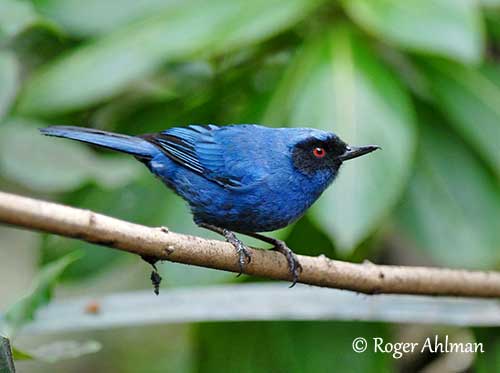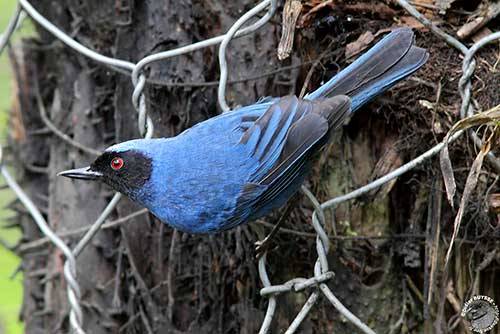
Fr: Percefleur masqué
Ang: Masked Flowerpiercer
All: Maskenhakenschnabel
Esp: Pinchaflor Enmascarado
Ita: Diglosssa mascherata
Nd: Maskerberghoningkruiper
Sd: svartmaskad blomstickare
Photographers:
Roger Ahlman
Pbase Galleries Peru and Ecuador
Didier Buysse
Vision d’Oiseaux
Ken Havard
My Bird Gallery & Flickr gallery 1 & Flickr gallery 2
Text by Nicole Bouglouan
Sources:
HANDBOOK OF THE BIRDS OF THE WORLD Vol 16 by Josep del Hoyo- Andrew Elliot-David Christie – Lynx Edicions – ISBN: 9788496553781
A GUIDE TO THE BIRDS OF COLOMBIA by Steven L. Hilty and William L. Brown - Princeton University Press – ISBN 069108372X
BIRDS OF SOUTH AMERICA – Passerines - by Robert S. Ridgely and Guy Tudor – HELM Field Guides – ISBN: 9781408113424
TANAGERS: Natural History, Distribution and Identification (Helm Identification Guides) - By Morton L. Isler and Phyllis R. Isler - Christopher Helm Publishers Ltd; New edition (30 April 1999) - ISBN-10: 0713651164
Neotropical Birds – Cornell Lab of Ornithology
Arthur Grosset's Birds (Arthur Grosset)
Wikipedia, la enciclopedia libre
Home page
Page Passeriformes Order
Masked Flowerpiercer
Diglossa cyanea
Passeriformes Order – Thraupidae Family
INTRODUCTION:
The Masked Flowerpiercer is a South American species of the family Thraupidae. This small bird inhabits montane forest and shrubby woodland in the Andes, at high elevation, where it frequents patches of Polylepsis.
It is often seen in mixed-species flocks with other flowerpiercers, various tanagers and hummingbirds, usually around abundant sources of nectar and small fruit. It occurs high in treetops, sometimes invisible in spite of its beautiful rich blue plumage.
This species is relatively common and the population is currently stable.

DESCRIPTION OF THE BIRD:
Biometrics:
Length: 15 cm
Weight: 17 g (12-22 g)
The Masked Flowerpiercer adult has deep rich blue plumage overall, with conspicuous black mask extending across the forehead, sides of head to behind eye, and forwards to the chin. Wing-coverts (except lesser), flight feathers, tertials and tail are black with broad blue edges.
The black bill is fairly long, slightly upturned, and hooked at tip. The eyes are bright red. Legs and feet are dusky.
The female resembles male, but her plumage is slightly duller.
Juvenile and immature are much duller and greyish, with almost entirely dull dark grey underparts. The black mask is indistinct. The base of the bill is pale and the eyes are dark.
The subadult has dark red eyes.
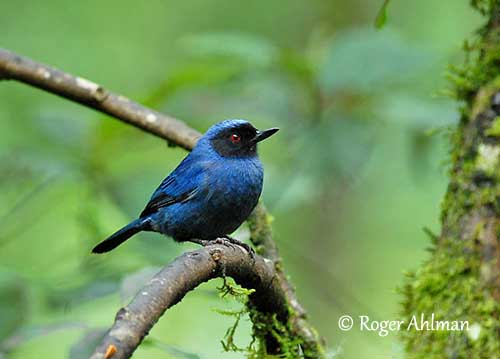
SUBSPECIES AND RANGE:
The Masked Flowerpiercer has five recognized subspecies.
D.c. obscura is found in the Sierra de Perijá in W Venezuela. This race has darker blue plumage overall.
D.c. tovarensis occurs in the coastal cordillera of N Venezuela. This one is brighter with paler blue forecrown, involving more contrasting black mask.
D.c. cyanea (described and displayed) is found in the Andes of Venezuela (S from Trujillo) and in Colombia and Andes of Ecuador, except for SW.
D.c. dispar is found in the Andes of SW Ecuador and NW Peru. This race shows a greenish tinge on the blue plumage.
D.c. melanopis occurs in the Andes of Peru (except NW), S to the Andes of Bolivia (to Santa Cruz). This race is slightly larger than others, and darker and duller than nominate.
HABITAT:
The Masked Flowerpiercer frequents humid forest and forest borders, montane forest and shrubby woodland, usually at high elevations up to the treeline, but mainly between 1,800 and 3,300 metres.
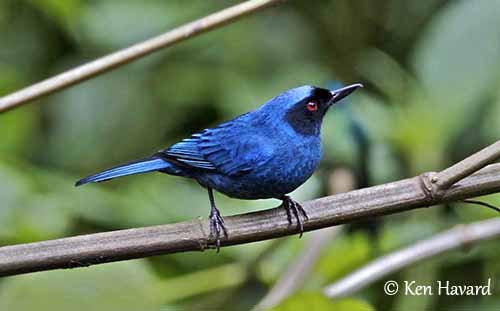
CALLS AND SONGS: SOUNDS BY XENO-CANTO
The Masked Flowerpiercer sings all year round. The nominate race utters two stuttering notes “zeet zee” followed by rapid tinkling and twittering, descending in pitch and accelerating.
Some differences occur between the songs of the northern and southern races. The song of the northern races is a series of thin notes followed by a twitter, whereas the southern races give a jumbled series of high-pitched notes followed by several drawn-out “tseeeee” notes.
The song is given from perch, with the bird partially hidden among the vegetation near the top of tree or bush.
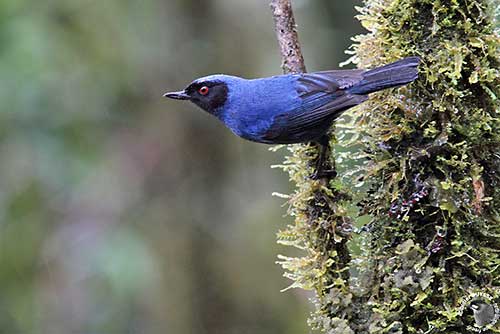
BEHAVIOUR IN THE WILD:
The Masked Flowerpiercer feeds primarily on nectar and small fruit, but it also takes seeds and insects. With its hooked bill, it attacks the flower from the base and then, it pierces the corolla to extract the rich nectar. However, the long bill and the small hook of this species allow the bird to reach the nectar into longer corollas by probing rather than piercing the base. And it usually feeds in this way.
The Masked Flowerpiercer regularly forages in pairs or in groups within mixed-species flocks, gleaning for insects, eating small fruit and probing into flowers for nectar. They usually forage at treetops, but occasionally low in fruiting bushes. But it rarely descends to the ground.
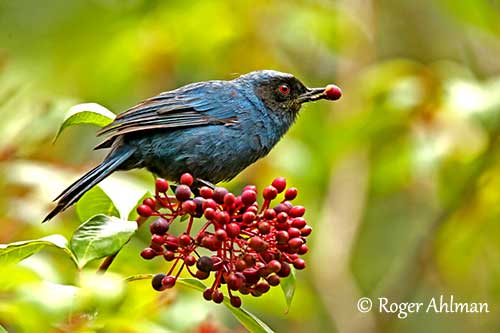
It moves quickly among the vegetation, hopping on mossy branches, twigs and vines, while searching for food. It may pierce some fruits for juice. Insects are caught by short sallies in the air, or found in bark crevices.
Interesting fact: several species of flowerpiercers can occur together locally at some sites in the Andes. The differences in bill and hook sizes allow the birds to avoid competition for food, as they feed on different food items and in different ways.
The breeding behaviour of the Masked Flowerpiercer is poorly known, but usually, the tanagers breed in monogamous pairs. They loosely defend a territory for at least part of the year, and can be aggressive towards intruders.
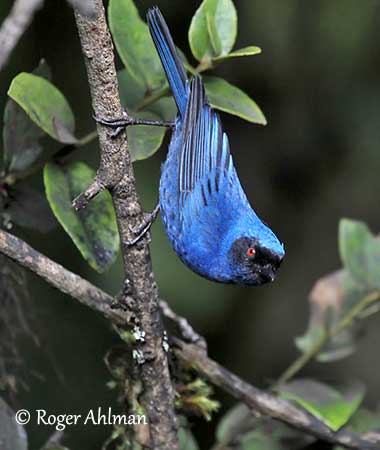
The Masked Flowerpiercer performs seasonal movements probably related to food resources, and altitudinal movements between higher and lower habitats. They may move in groups of 20-30 birds.
They are good fliers but they move on relatively short distances.
REPRODUCTION OF THIS SPECIES:
The Masked Flowerpiercer breeds between June and September in the Andes. However, fledglings can be seen in December, March and April in Venezuela and Colombia, and March, May, July and December in Peru and Bolivia.
This species may produce two broods per year.
The nest is an open cup made with grass and moss, and lined with feathers. It is often built in bush. The eggs are pale greenish-blue with red-brown and lilac spots on the large end. The incubation is probably performed by the female alone, but the chicks are fed by both parents. No more information.
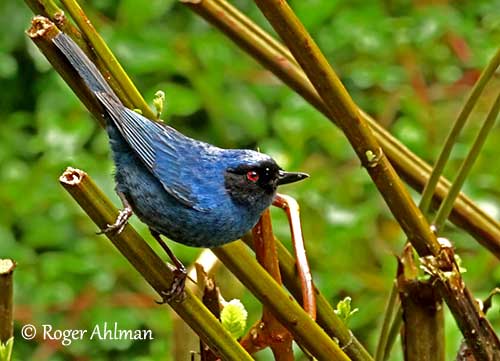
PROTECTION / THREATS / STATUS:
The Masked Flowerpiercer has large range in which it is common and widespread. This species occurs in numerous protected areas including national parks and natural reserves where both birds and habitats are protected. However, this species also occurs in manty wild areas of montane forest with more or less risk for the birds and their habitat.
The population is suspected to be stable, and currently, the Masked Flowerpiercer is evaluated as least Concern.
